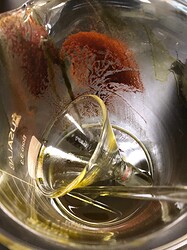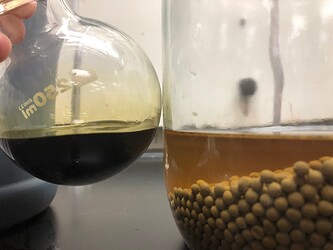This is more or less a pt II of the ‘methanol winterization with salt?’, since I no longer need to use only organic ethanol, I can pull out some of my old school techniques that I know many of you here have been using for a while. The obvious being methanol dewaxing as a less equipment intensive winterization needing about -20c. What I was more excited to try was LLE. I come from a chemistry background and I’ve done a lot of LLEs and it is nice to be able to use even simple solvents.
Let’s get to it. For context, I extract with warm ethanol and used a methanol dewax, which did a lovely job pulling a large plug of wax and a fair amount of green leaving the characteristic brown oil. I decided to remove the methanol (65C) water (90C) and decarb (120C) in my rotovap to check my yield and remove some volatiles while I was at it. The oil was smooth with no insoluble material so I let the rotary flask cool to ~90C and poured the oleo into 2 volumes of heptane and a large amount of precipitate formed. At the bottom of the container. Concerned this was cannabinoids, I mixed it thouroughly and transferred the mixtures to 1 gallon HDPE jugs and let them sit overnight. A small amount of the precipitate stuck to the sides so I washed it with a bit of cold heptane and it revealed a red powder!
The powder was readily soluble in water, methanol, slightly soluble in ethanol and acetone, and insoluble in isopropanol (99%), which yielded an orange color characteristic of CBD distillate (though this is THC material). I dissolved some in water and gave it a quick taste (after the heptane evaporated ![]() ) and it tasted exactly like a burnt popcorn kernal oddly enough but was not unpleasant even when concentrated.
) and it tasted exactly like a burnt popcorn kernal oddly enough but was not unpleasant even when concentrated.
The next day I had a fritted buchner funnel that I slurry packed a celite cake (200g) followed by a 50g of T1 activated charcoal both suspended in heptane. I didn’t have any bentonite on hand so I just used what I had. I also prefer to filter before my washes as I find this gets a lot of insoluble stuff out and cuts down on aqueous waste.
I performed a standard acid/base wash and I was surprised when the washes all came out clear. I started with ph 4 and 9, so I pushed it a bit and went to 2.5 and 11 just to see if anything would happen and still no color (the quantities I did were 500 mL heptane oleo 2:1, doing 3 50ml washed using citric acid, KOH, both saturated with NaCl). Some of these washed had the slightest yellow-green tinge but nothing I could say for sure.
As a last ditch effort to see something, I decided to do a volatile strip and add 25mL of methanol followed by ~250/500mL of water (done 3 times total). This did yield a brown aqueous/methanol layer and it came out more or less white/yellow on the 3rd wash. After a pH balance and drying over some 4a mol sieves, I passed it through my frit with some celite to filter fine sieve particulate and rotovaped it down. Curious to see how it distills.
Wow. Quite a bit here. Anyone wants to put their best guess foreword, please do. I will as well in a reply, just wanted to keep this shorter. Apologies if this is a redundant thread btw, I’ve read almost every LLE thread I can find and I didn’t see anything on this. Cheers. (images to come soon).
Edit: Added photo of preipitate

